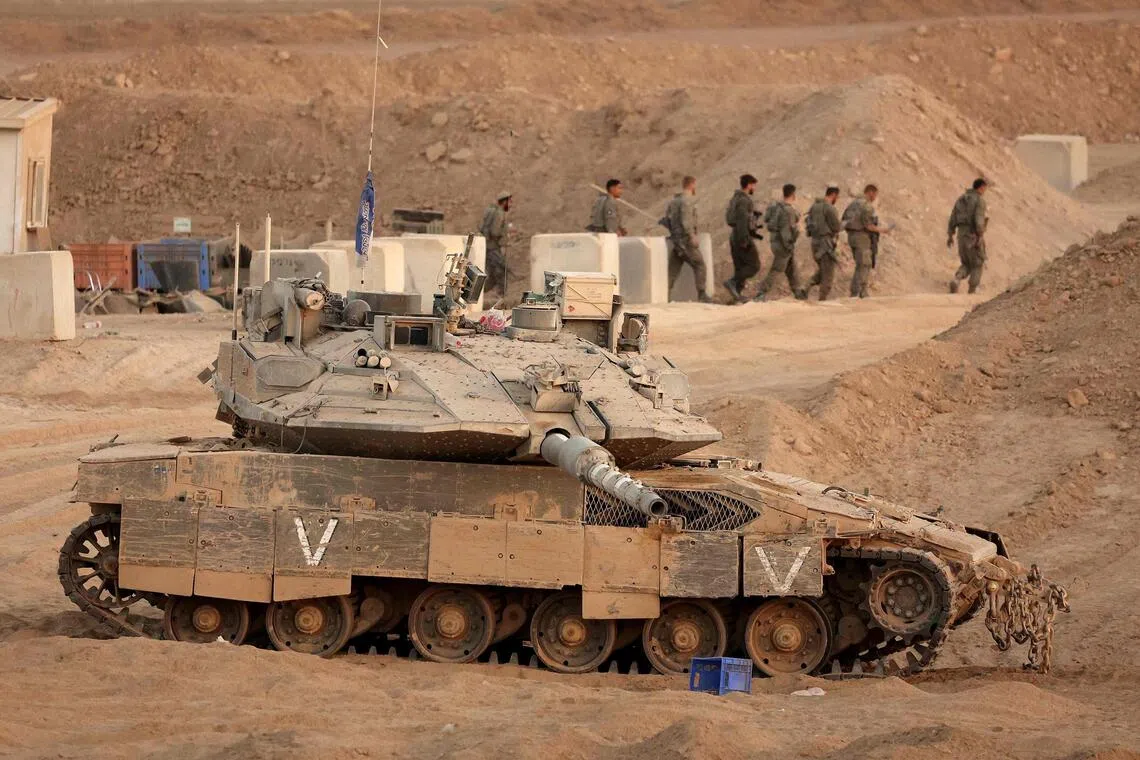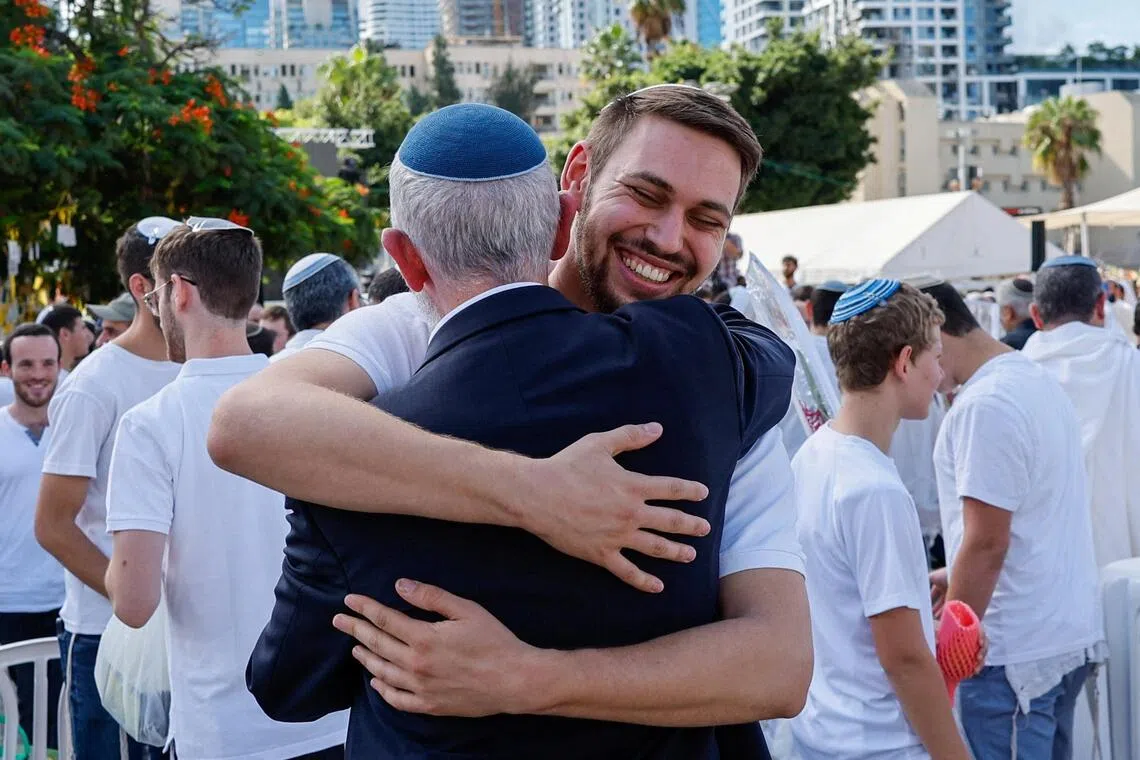Gazans stream towards wrecked homes as Israeli forces start pulling back under ceasefire
Sign up now: Get ST's newsletters delivered to your inbox

Israeli forces have begun pulling back from parts of Gaza, particularly in Gaza City and Khan Younis in the south.
PHOTO: AFP
Follow topic:
JERUSALEM – Thousands of displaced Palestinians streamed back towards their abandoned homes on Oct 10, after a ceasefire between Israel and Hamas went into effect and Israeli troops began pulling back from parts of Gaza.
A huge column of displaced Gazans filed north through the dust towards Gaza City, the enclave’s biggest urban area, which had been under attack just days ago in one of Israel’s biggest offensives of the war.
“Thank God my house is still standing,” said Mr Ismail Zayda, 40, in the Sheikh Radwan area in Gaza City.
“But the place is destroyed, my neighbours’ houses are destroyed, entire districts have gone.”
The Israeli military said the ceasefire agreement had been activated at noon local time (5pm Singapore time).
Israel’s government ratified the ceasefire with Hamas
Hamas is expected to release the 20 living Israeli hostages within 72 hours, after which Israel will release 250 Palestinians serving long terms in Israeli prisons, and 1,700 others detained in Gaza during the war.
US special envoy to the Middle East Steve Witkoff said the Israeli military had completed the first phase of a withdrawal in Gaza, and the hostage release period had started.
Once the agreement is operating, trucks carrying food and medical aid will surge into Gaza to help civilians, hundreds of thousands of whom have been sheltering in tents after Israeli forces destroyed their homes and razed entire cities.
The first phase of US President Donald Trump’s initiative
In a televised address, Prime Minister Benjamin Netanyahu said that Israeli forces would stay in Gaza to ensure the territory was demilitarised and Hamas disarmed in future stages of Mr Trump’s plan.
“If this is achieved the easy way, then that will be good, and if not, then it will be achieved the hard way,” he said.
Israeli military spokesperson Brigadier-General Effie Defrin urged residents of Gaza to avoid entering areas under Israeli military control.
“Keep to the agreement and ensure your safety,” he said on Oct 10.
In Khan Younis, in the southern Gaza Strip, some Israeli troops pulled back from the eastern area near the border, but tank shelling was heard, according to residents in contact with Reuters.
In Nuseirat camp, in the centre of the enclave, some Israeli soldiers dismantled their position and headed east towards the Israeli border, but other troops remained in the area after gunfire was heard in the early hours of Oct 10.
Israeli forces pulled out from the road along the Mediterranean coast into Gaza City.
“As soon as we heard the news of the truce and ceasefire, we were very happy and got ready to go back to Gaza City, to our homes. Of course, there are no homes. They’ve been destroyed,” said Mr Mahdi Saqla, 40. “But we are happy just to return to where our homes were, even over the rubble. That, too, is a great joy. For two years, we’ve been suffering, displaced from place to place.”
War is over
The war has deepened Israel’s international isolation and upended the Middle East, spreading into a regional conflict that drew in Iran, Yemen and Lebanon.
It also tested the US-Israeli relationship, with Mr Trump seeming to lose patience with Mr Netanyahu and pressuring him to reach a deal.
Israelis and Palestinians alike rejoiced after the deal was announced
Hamas’ exiled Gaza chief Khalil Al-Hayya said he has received guarantees from the United States and other mediators that the war was over.
Twenty Israeli hostages are still believed to be alive in Gaza, while 26 are presumed dead, and the fate of two is unknown.
Hamas has indicated that recovering the bodies of the dead may take longer than releasing those who are alive.
Hurdles remain
The accord, if fully implemented, would bring the two sides closer than any previous effort to halt the war.
Much could still go wrong.
Both sides have yet to publish the list of Palestinian prisoners to be released in exchange for Israeli hostages. Hamas is seeking freedom for some of the most prominent Palestinian convicts held in Israeli jails.
Further steps in Mr Trump’s 20-point plan have yet to be agreed. Those include how the demolished Gaza Strip is to be ruled when the fighting ends, and the ultimate fate of Hamas, which has rejected Israel’s demand that it disarm.
The Hamas-run Interior Ministry said it would deploy security forces in areas where the Israeli army withdrew. It was not clear whether armed militants would return to the streets in significant numbers, a move Israel would see as a provocation.

Israeli worshippers celebrate the Jewish holiday of Sukkot at “Hostages Square” in Tel Aviv after Israel’s government ratified a ceasefire with Hamas.
PHOTO: REUTERS
Mr Trump said he would head to the region on Oct 12, possibly to attend a signing ceremony in Egypt, and Israeli police said they were preparing for a visit by him on Oct 13. Knesset Speaker Amir Ohana invited him to address the Israeli Parliament.
The deal received support from Arab and Western countries and was widely portrayed as a major diplomatic achievement for Mr Trump.
The United States will deploy 200 troops
The officials, speaking to reporters on condition of anonymity, said the 200 would be a core part of a task force that would include Egyptians, Qataris, Turks and probably Emiratis.
More than 67,000 Palestinians have been killed in Israel’s assault on Gaza, launched after Hamas-led militants stormed through Israeli towns

